#Format: CD Compilation Reissue
Explore tagged Tumblr posts
Audio
Cock Sparrer –Riot Squad
#Cock Sparrer#Rumours Carry More Weight Than Fact (The Best Of Cock Sparrer)#Riot Squad#Format: CD Compilation Reissue#Released: 1994#Genre: Punk Oi#uk
18 notes
·
View notes
Text










10 GREAT GARAGE ROCK ALBUM CLASSICS
The Garage sub-genre of Rock is one where the 45 RPM single is King. Garage developed in the mid-1960s in the wake of the British Invasion as thousands upon thousands of teenage kids bought musical instruments, and formed bands in a bid for fame, and fortune. Garage Rock fused with Psychedelia as the decade wound to a close, but very few bands from that movement were around long enough, or were fortunate enough to be allowed to make a full-length album. Most - if they recorded at all - cut one or two 45s that were regional hits, and then the bubble burst and the members got married, and found day jobs, or they went to war, or turned to less-legal pursuits.
In the wake of Lenny Kaye's 1972 Nuggets compilation album of the best records of that period, the term Garage Rock was coined, and by the time the CD arrived, the market became flooded with hundreds of various artists collections of 45s from all over the country. But there weren't very many original, noteworthy full-length albums by even the most successful bands of the era. Even today, much of what you'll find in that format are compilations of 45s, demos, and outtakes sourced from studios who were sitting on master tapes for decades before anyone bothered to notice there was money to be made from them.
So, I thought it might be worth taking note of 10 of the best Garage Rock LPs cut by some of the best bands of the genre while they were still together. If you dig deep enough you can probably find original vinyl pressings, reissues, or CDs of them all. (I think some enterprising cassette manufacturer ought to issue them as well since it's likely few, if any of them were ever issued in that format.) Here's my list:
Why Pick On Me? - The Standells
Present Tense - Sagittarius
Here Are The Sonics - The Sonics
The Rationals
The Psychedelic Sounds of the 13th Floor Elevators
Back Door Men - The Shadows of Knight
The Remains
Psychedelic Lollipop - Blues Magoos
Just Like Us! - Paul Revere & The Raiders
Raw & Alive - The Seeds
12 notes
·
View notes
Text




A TASTY 20-TRACK SAMPLER OF PURE, COMPLETE, & UTTER DISORDER -- NOT FOR POSERS.
PIC(S) INFO: Spotlight on "The Complete Disorder" CD compilation by Bristol, UK punk rock band DISORDER, collecting all of their singles on a "bargain pack," and released as part of The Punk Collectors Series under Anagram Records in 1991, and repressed again in 1995. Made in England.
LABEL: Anagram Records – CD PUNK 46
SERIES: The Punk Collectors Series
FORMAT: CD, Compilation, Reissue
COUNTRY: UK
RELEASED: 1995
GENRE: Rock
STYLE: Punk
Source: www.discogs.com/release/2204173-Disorder-The-Complete-Disorder.
#DISORDER#DISORDER band#80s punk#DISORDER The Complete Disorder#CDs#DISORDER punk#Second Wave UK punk#80s#Bristol punk#Hardcore punk#DISORDER UK#Bristol UK#Anagram#80s hardcore#The Complete Disorder#Anagram Records#Punk rock#Real punk#CD Compilation#CD#💿#Compilation#Compilations#Bristol#CD Compilations#Compact Disc#1980s#Bristol UK punk#Raw punk#UK punk
2 notes
·
View notes
Text
Tears for Fears - The Hurting (Steven Wilson 5.1/Atmos/Instrumental) Blu-Ray Audio
Slightly over a year after the first Blu-Ray audio disc in the "SDE Surround Series", said series circles back to the band that began it all.
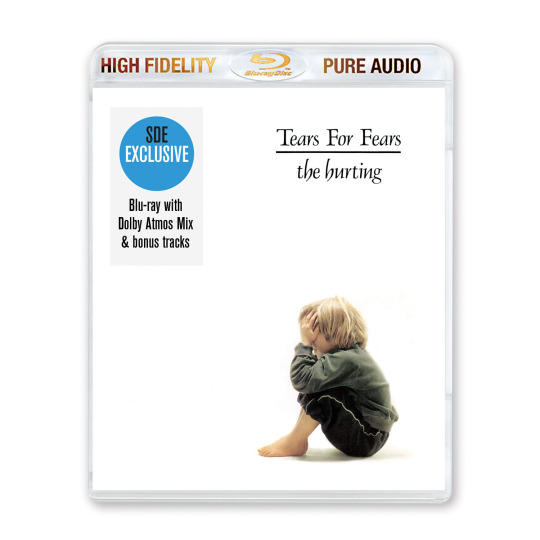
Steven Wilson (renowned musician and engineer) wasn't involved yet when Universal (helped by Paul Sinclair and Steve Hammonds) compiled the 30th anniversary box set of The Hurting in 2013. Looking back, it almost appears modest. None of the tracks were previously unreleased, although many were on CD for the first time, and the concert video In My Mind's Eye made its first official DVD appearance.
The High Fidelity Pure Audio initiative started in 2012, and in early 2014, The Hurting was released in this format, but only in stereo. This disc is one of many good examples why the BD-A format never really took off: It was seen as pointless by most music buyers.
As Songs from the Big Chair was a bigger album, Universal then brought Steven Wilson on board to create a new stereo and 5.1 mix. Both were included on a DVD-A within the box set, but also on a standalone Blu-ray Audio - a much more attractive release than the Hurting BD-A. Nevertheless, the format fell out of favor. Blu-ray Audio continued to exist (both standalone and in box sets like Steven Wilson's 5.1 of The Seeds of Love), but the series was over after 2016. Until Paul Sinclair brought it back from the dead with the exclusive The Tipping Point Blu-ray.
That release, it turned out, was just the beginning of a series. Follow-up Blu-ray discs have been made of albums by xPropaganda, Gilbert O'Sullivan, Shakespear's Sister, Brian Eno, Orbital, Ten Years After and most recently none other than Bob Dylan!
Now for the 40th anniversary of The Hurting, Steven Wilson created not just a 5.1 mix but also a Dolby Atmos one (which will also be listenable on streaming sites, but the other mixes are exclusive to this disc), as well as an instrumental mix of the whole album!
Another find is two bonus tracks - versions of "Mad World" and "Watch Me Bleed" from the aborted Mike Howlett sessions (the original b-side mixes of "Ideas as Opiates" and "We are Broken", which were erroneously missing from the 2013 box set, are absent, though).

So we're getting four different versions of the album:
Dolby Atmos
DTS-HD 5.1
Original stereo mix (apparently/hopefully a new remaster)
Instrumental mix (hi-res stereo)
Plus two bonus tracks (stereo):
Mad World (Mike Howlett Version)
Watch Me Bleed (Mike Howlett Version)
The exclusivity and various tax/customs shenanigans haven't gotten any better since last year for me, but at least the offering appears quite a bit more generous than The Tipping Point. Still, I'm definitely glad none of the other SDE Blu-ray discs were anything I needed to have. (If I lived in the UK, I probably would've gotten more of them.)
As with the second pressing of the Tipping Point blu-ray, the number of copies of this disc is going to be pressed based on how many are preordered until March 17.
There's also a new half-speed mastered vinyl reissue of the album.
Store link:
Article:
#tears for fears#the hurting#steven wilson#music#80s music#roland orzabal#curt smith#tff#blu-ray#album#surround#dolby atmos#instrumental#unreleased#synth pop#goth rock#arthur janov#primal scream#primal therapy#therapy#preorder
9 notes
·
View notes
Text


Today's compilation:
Oldies But Goodies, Vol. 1 1987 Doo Wop / Pop / R&B / Rock & Roll
Alright, folks, this is probably the last time that I'm gonna be typing out the name Art Laboe for a long while. He's the legendary Los Angeles radio DJ who did a lot of things in his career, including pioneering the art of repackaging oldies hits into various artist compilations—a seemingly simple format that you've likely taken for granted your whole life. However, before Laboe's groundbreaking Oldies But Goodies series was launched in the 50s—a phrase that he himself apparently coined!—scratching one's own nostalgia itch was a much more laborious task than just throwing on a single record to relive some of your faves from years past.
Now, upon its release, this series wound up selling like hotcakes, and it ended up yielding 15 different volumes in total. But as years would go by, rather than releasing more and more volumes after 1985, Laboe's label, Original Sound, insisted on retooling and reissuing these same albums with different tracklists instead. So, this compilation here was released as the first volume in the series, but it's actually a 1987 CD reissue, and its tracklist is markedly different from the actual first volume that had initiated this whole phenomenon decades prior.
Still though, the album's pretty good. Its first half is dominated by sappy doo wop ballads, which is the type of doo wop that I'm not too big a fan of, but it branches itself out nicely in the second half, closing out with a run of four unmistakable killers: Chuck Berry's landmark 1955 debut record, "Maybellene," which was one of the first songs to show people what rock & roll guitar could truly be capable of; The Cadets' "Stranded in the Jungle," an off-beat, moving and grooving 1956 one-hit wonder novelty, with deep-voiced spoken-word verses and jaunty bouts of horn and piano on its choruses; Lloyd Price's superbly catchy and highly popular 1958 New Orleans R&B rendition of "Stagger Lee;" and Etta James' 1955 debut record that never got any play on pop radio because it was deemed too risqué, but crushed it on the R&B chart anyway, "Dance With Me Henry," aka "The Wallflower," aka "Roll With Me Henry."
So, overall, out of all the Oldies But Goodies that I've now had the pleasure of diving into, this 1987 reissue of Volume 1 is probably my least favorite. But its final quartet of tunes is really nothing short of fantastic, and I just wish that the album could've been made with that same consistency all throughout, like a lot of other releases in this essential series seem to be.
Definitely not done with checking out oldies altogether, but I think I'll be putting this specific, history-making series to bed for the time being. I plan on revisiting it again someday, but that day is an indeterminately long way's away.
Highlights:
Chuck Berry - "Maybellene" The Cadets - "Stranded in the Jungle" Lloyd Price - "Stagger Lee" Etta James - "Dance With Me Henry"
#doo wop#r&b#rhythm and blues#r & b#rhythm & blues#rock & roll#rock and roll#pop#classic rock#classic pop#oldies#music#50s#50s music#50's#50's music#60s#60s music#60's#60's music
5 notes
·
View notes
Text







V.A. - UNDERGROUND OF THE 2000 MADE IN SHANGHAI 地下上海(赛剋克 psychic/china 2*cd+booklet 2022)
Around 20-23 years ago, I participated in or formed three rock bands, namely Godot, Nutcracker and JUNKYARD. The styles of these three bands were noise rock, post punk and no wave. In 2004, I began to break away from the shackles of traditional music. Into the world of noise, I formed the harsh noise band Torturing Nurse. The current compilation album "UNDERGROUND OF THE 2000 MADE IN SHANGHAI 地下上海" of the previous three bands is currently reissued by the Chinese label 赛剋克 psychic on 2*cd+ booklet format, for details, please refer to:https://mp.weixin.qq.com/s/cWGiX0Ge9ZVoBujGFn28fQ
3 notes
·
View notes
Text
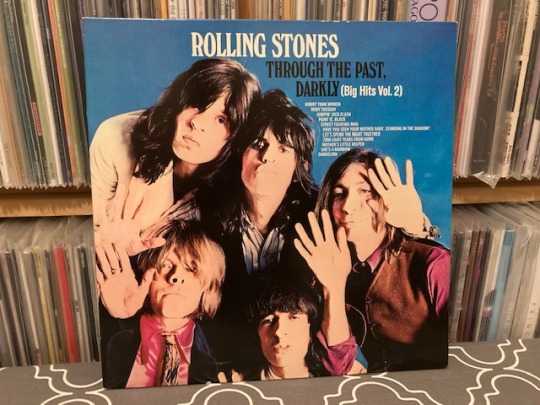
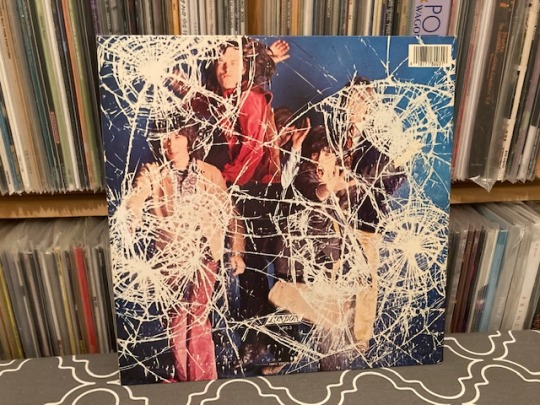
12 August 2022: Through the Past, Darkly (Big Hits Vol. 2), The Rolling Stones. (1986 ABKCO reissue of 1969 Decca/London compilation)
The Stones discography, up to the point of departing Decca in the UK and London in the US for their own, Atlantic-owned Rolling Stones Records imprint, received a US vinyl reissue campaign in 1986. Many of these dozen-or-so albums had long been out of print. Like the Beatles, who would get a similar treatment by Capitol beginning the following year, the Stones got digital remasterings for this campaign that occurred on vinyl as well as CD. Also like the Beatles, the first several Stones albums were different in the US versus their UK homeland, and this campaign followed the US versions of those albums. (The Beatles campaign followed the UK versions, which have been treated as the definitive worldwide versions ever since.) Unlike the Beatles, whose ’80s reissue campaign I attempted to buy in real time, I didn’t fret the Stones reissues until roughly twenty years later. I did buy Let It Bleed from the campaign when it was new, but didn’t feel a need to pick up the others. I’ve just never been a diehard Stones fan, but at one point I realized I should probably have all of these albums. As of this past summer, there were still several titles from this campaign that I didn’t own. Some of them—including the subject of today’s post—I have original versions of; two of them, namely the 1966 comp Big Hits (High Tide and Green Grass) and Aftermath, I don’t own in any format. (I do have a horrifically warped copy of Aftermath; I finally found a sealed copy of the 1986 reissue on eBay and no one could have known it was ruined without opening it.) I’m not too worried about finding Big Hits, though I would like to get a replacement copy of Aftermath. Should I ever see a copy of the 1986 version of Their Satanic Majesties Request (I don’t think I’ve ever seen one), I’ll probably pick it up, even though unlike my original copy it does not have a lenticular cover. (One notable thing about the 1986 reissues is the version of Beggars Banquet uses the original, banned cover art of a heavily graffitied toilet-stall interior.)
It was superfluous of me to buy this copy of Through the Past, Darkly, but seeing it came from the ’86 series I instantly wanted it, but I also was interested because I think it’s the first time I’ve seen this album with a square cover. Originals are in an octagon shape (details on this below).
Above are the front and back covers of the reissue.
Below is the opened gatefold.
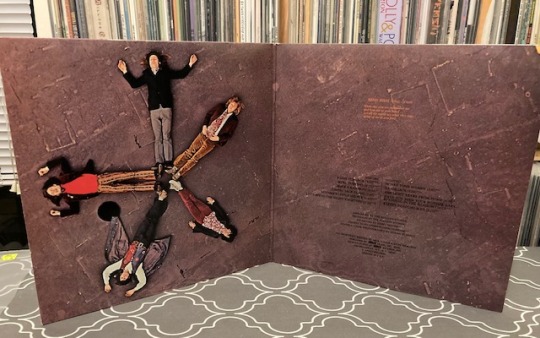
Here is side one’s label. The labels of all entries in this reissue campaign look like this.

For comparison, here is my original US pressing of the album. This was a must-have for a young record collector like me, just due to the novelty of its sleeve shape.
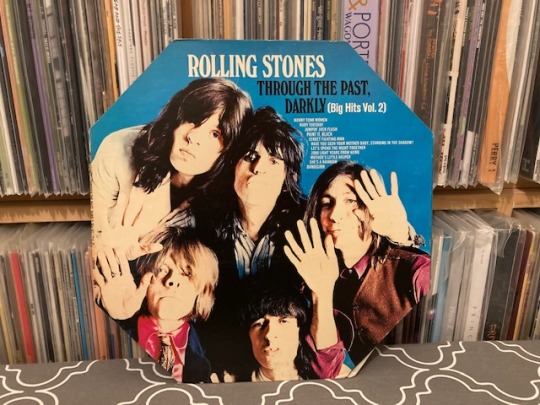
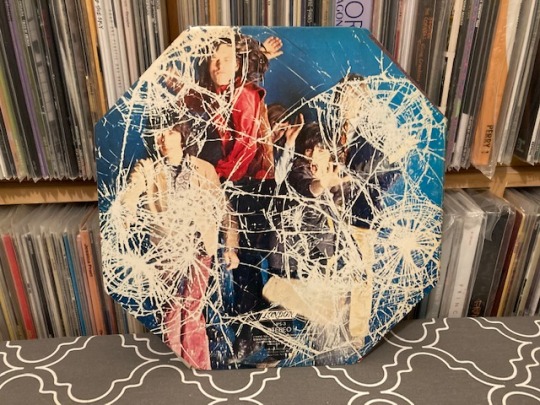
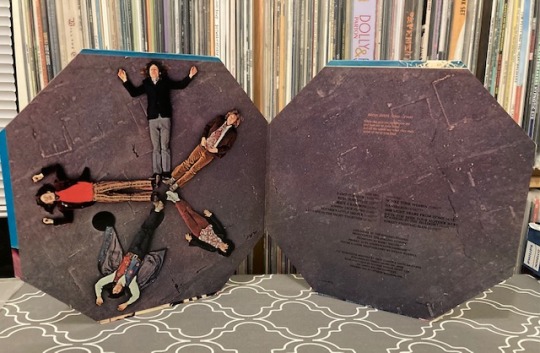
The inner sleeve is a regular square one, folded to fit the octagon shape.
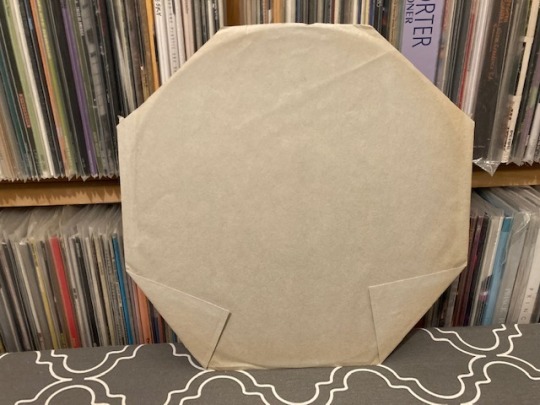
The silver-and-blue London label is hard to photograph.
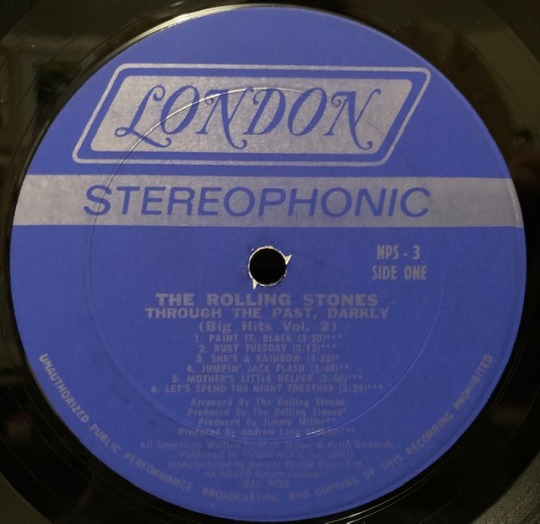
Forgive the reflection of my hand holding a phone here—I wanted to capture that little green dot in the dead wax. This telltale sign proves to me that I purchased this title at Recycled Records in Springfield, Illinois. This would have been sometime in the ’80s. Recycled Records did this with all of their used albums to prevent sneaky people from cheating them. The price tags were always on the aftermarket plastic sleeve the shop put everything in, and if anybody decided to swap sleeves to try to get a cheaper price, Recycled Records had them fooled. I prefer to take these little dots off, but the adhesive was always so sticky that it left a mess behind if you did manage to remove the dot. I wasn’t sure upon seeing this if the price was $6 or $9 (I’ve long since removed the original price tag on the outer sleeve), but $9 seems impossibly high for a relatively common title in the ’80s at Recycled Records, so I’m wagering I paid $6 for this.
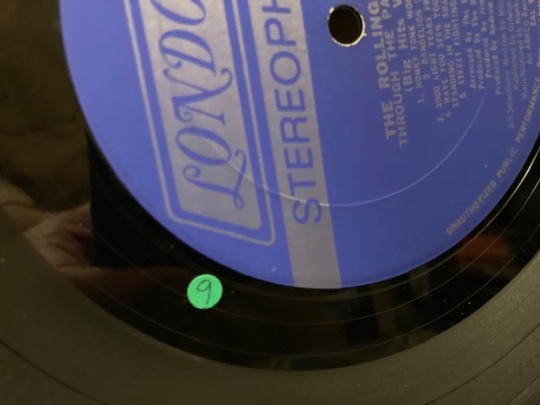
1 note
·
View note
Text

youtube
"Jazz Heroes 1959-1961 Vol. 10" (2014, Naïve) reissues Ornette Coleman's 1959 The Shape Of Jazz To Come in a CD compilation format. Here's "Lonely Woman". w/ Ornette, my father, trumpeter Don Cherry, drummer Billy Higgins.
1 note
·
View note
Text
#5: Fats Domino - This Is Fats Domino! (1956)

Wow, the 1001 Albums guys really made me work for this one. This thing is out of print on every format. It's not on streaming. I resorted to a poor quality rip of a bootleg-adjacent CD reissue on YouTube. I actually listened ahead a couple releases and sandbagged this one with the hopes of finding a better quality version of it somewhere. I normally wouldn't complain, but a core tenet (supposedly) of their selection criteria is physical accessibility, prioritizing albums that are in print or easily found and heard. And this isn't an issue with it just recently vanishing: at the time of the book's first publishing in 2005, the album had been out of print in the US since the 1969 "forced stereo" LP reissue (which itself got a few early reprints at unknown years, I'd estimate based on the labels that the most recent is from the early 70s). If you wanted to hear the original mono recording you better have been ready to track down an original. There had been a handful of European and Japanese reissues, but I can't imagine many folks wanting to pay import prices for this. And it never hit the CD til the aforementioned bootleg-adjacent 2008 Dutch reissue (notably with the wrong name, making the easy mistake of conflating it with his 5th album, This Is Fats), with the only other CD issue being a spendy Japanese version from 2016. None of the versions I looked at were particularly expensive today for what they are, but certainly inconvenient to acquire, requiring the listener to buy used off of eBay or Discogs and understand different pressings, Goldmine gradings, etc. If I ran the zoo I would have pivoted to one of his other 50's albums, most of which are at least readily available on streaming if not in print. Obviously streaming wasn't at the forefront of their minds in 2005, but the newer editions have no excuse.
Anyways, the album! Like it says on the tin, it's Fats Domino. He's a bit of a one trick pony, but he also invented rock n roll so let's cut the man some slack (ok, debatably invented, but about as good a starting point as any in my book). This is a fun listen. If you've heard early rock music you won't find any surprises here, but you won't complain about hearing it either. And you certainly can't understate his influence on music and culture. It may not seem like as much today, but swinging 12 bar blues and beating up the piano was an earth-shaking event at the time, and his contributions to music are invaluable. My only other note is that the recording quality seemed particularly poor on this one, even for the era, but it's hard to say when you're listening to a budget Dutch needledrop through YouTube audio compression on a 480p video.
All that being said, I really would have liked to see mention of Sister Rosetta Tharpe somewhere in here as we dig through the origins of rock. Obviously she predates the concept of the LP by a bit, but there are plenty of compilations out there of her early sides, and plenty of (comparatively) more modern live material to pull from. If you know you know, and if you don't know then I'm here to tell you that the godmother of rock n roll was a mighty black woman who shouted gospel and wielded a triple humbucker Gibson SG.
Ok, I've gotten far enough off topic enough times now that I feel like I'm being rude to the legendary Fat Man, so let's put a bow on this thing. MUST you hear This Is Fats Domino!? Yes, with the caveat that your head might hurt less if you just pull up one of his other albums on your streaming service of choice; they're all equally good in my book.
Next time: we keep court with one of the highest ranking members of jazz royalty, Duke Ellington, and his 1956 live album Ellington at Newport!
#1001 albums#1001 albums you must hear before you die#1001albumsrated#album review#now spinning#Fats Domino#This Is Fats Domino!#rock n roll
1 note
·
View note
Photo

Michael Cuscuna by Jimmy Katz
Michael Cuscuna R.I.P. 1948-2024
Our fantastic friend, then client, Michael Cuscuna, record producer/historian extraordinaire and co-founder of Mosaic Records, passed away on April 19, 2024. Both of us –Alan and Fred– wrote remembrances that we’re reposting here.
.....
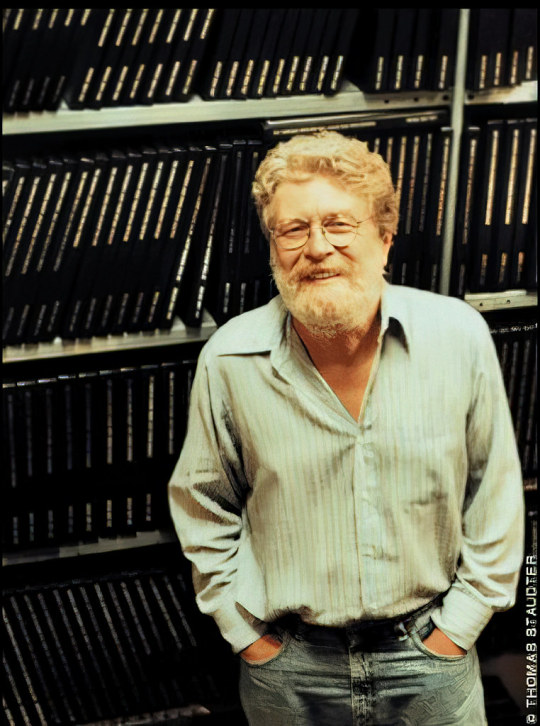
Michael Cuscuna by Thomas Staudter
I knew the voice of Michael Cuscuna before I ever met the man. Growing up in an area of New Jersey where we could pull in both New York and Philadelphia stations, I would listen to him DJ at WMMR out of Philly. He had a quintessential FM DJ voice — soft-spoken, intimate, gravelly, authoritative. He didn’t yammer on, but I remember he was clever and his sense of humor was dry as a bone. He played a mix of progressive rock and some things that clung to the precipice of musical genres.
Years later our paths merged. I started seeing his name on the backs of albums I’d play on my college jazz radio show — now I was the DJ, and he had become a prolific producer, supervising dates for a diverse list of artists, including many dedicated to the avant garde. He also produced for Bonnie Raitt and other groundbreaking musicians. I am searching my memory in vain to recall how we became connected, but he was also creating a monthly promo disk sent to radio stations by Crawdaddy Magazine and I became his producer, using the free facilities of the college station to record and edit. He would collect the interview tapes from the magazine’s feature writers, I would edit them into a coherent radio show, then he would come in and record his host segments. Out of that association, I started writing reviews for Crawdaddy of new jazz releases. He was as wickedly funny in person as I remembered him on the radio. I was a little in awe of his extraordinary knowledge of music — an artist’s historical significance, how a musician’s style linked that person to the artists that came before and after, and why certain artists deserved more recognition than they had received by the public. He turned me onto a lot of music. I think we did the show for a couple of years.
More time passed, and Michael came into my life again through my partner at our media advertising agency, Fred/Alan. By now, Michael had established himself as an important compiler of jazz reissues that went above and beyond what was typical at the time. Starting with Blue Note Records, but ultimately including the libraries of other labels, he’d go into the vaults and unearth the unreleased sides and alternate takes and place them alongside the more well-known songs. His two-fer series for Blue Note was particularly noteworthy. On the back of that success, he and a former Blue Note executive named Charlie Lourie created Mosaic Records. Their concept was to do numbered, limited editions in luxurious box sets aimed at the collector market. Initially vinyl only, they switched to CDs when that was the prevailing release format. The boxes were gorgeous, each with a booklet filled with photos, an essay by a prominent jazz historian, and absolutely accurate discographical information. They specialized in “complete” collections depending on the frame they decided was relevant. That frame might have been the three-day recording binge from 1957 by organist Jimmy Smith that resulted in enough material for three CDs, the unreleased complete recordings of Charlie Parker’s live solos recorded by Dean Benedetti, or the complete Capitol recordings of the Nat King Cole trio, a box that weighed-in at 18 CDs. They were sold only through the mail, direct to consumers. But they weren’t reaching the market and needed help. In an earlier era, my partner Fred Seibert had attached himself to Michael to learn as much as he could about producing records. Knowing the two of us, Michael asked if we could come up with a direct marketing campaign. In our typically arrogant belief that we knew how to do almost anything or could figure it out, we said yes.
We began producing a catalog that was mailed out to jazz enthusiasts, slowing building a list of devoted listeners and buyers. My job was to write that catalog. We dissolved the advertising agency in 1992, and mailed catalogs gave way to internet promotion, but I continued writing the sales copy for each release, save one or two that I didn’t do for reasons lost to time. I just wrote one last month for an upcoming set featuring vibraphonist Bobby Hutcherson.
I developed a format for my essays. I started with some thesis about why that artist deserved more recognition, or why the music from that era was crucially important — in other words, why you absolutely had to own that collection. I segued into a couple paragraphs of biography, followed by a few paragraphs where I singled-out important tracks or tried to convey in words the feeling, the sound, the artistry of the musician. I wrapped it up with more “don’t delay” language. In all those years, each and every time I approached a new assignment I had two thoughts crowding my mind — will Michael agree with my thesis? Will Michael take issue with the way I chose to describe the music? Each package gave me an opportunity to do a deep dive into the music, but I knew I didn’t have Michael’s personal connection to many of the artists, or his historian’s perspective on the music. And by the way, he was himself a damn good writer. It never stopped thrilling me when he’d send back an email merely correcting a calendar date, or the number of unreleased tracks, with a message that he thought it was otherwise perfect. More than anything I wanted to impress and satisfy Michael. I was alway so happy that I could.
I think they had done four releases when we got involved in 1984. The company is closing in on 200 box sets. I can’t believe it’s been a 40-year association.
We lost Charlie more than 20 years ago. This weekend, Michael passed after a long illness. I will miss his husky laugh, his personal stories about the musicians we both obsessed over, and the gratitude he expressed each time I turned in an assignment.
To many, his name was a name on the back of an album jacket. To those of us who knew him, we know him as someone who single-handedly rescued the Blue Note archive and other treasures from oblivion, who introduced us to overlooked artists such as saxophonist Tina Brooks, and who demanded we take a second look at music that was significant and mind-blowing. As a colleague, as a client, but mostly as a music lover, I am forever in his debt. My sympathies to the family of this enormously important figure in music. RIP Michael Cuscuna.
–Alan Goodman (repost from Facebook)
.....
Michael Cuscuna, photograph by Jimmy Katz
Michael Cuscuna
Michael Cuscuna, one of my great inspirations and sometime collaborator, passed away this weekend (April 19, 2024) from cancer. Being a cancer survivor last year myself, when someone I’ve known and worked with for over 50 years it hit particularly hard.
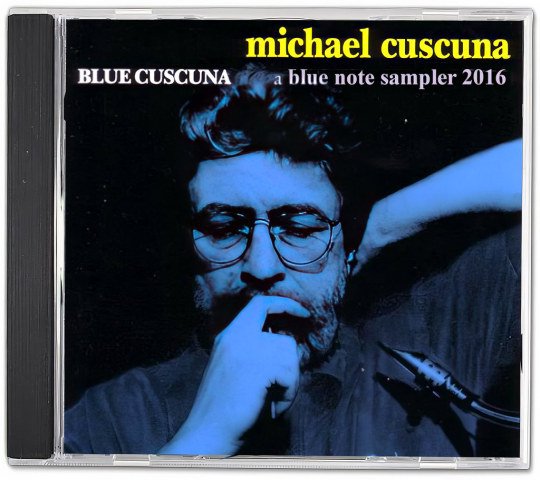
Blue Cuscuna: 1999 promotional sampler from Toshiba-EMI [Japan]
Michael has been the most consequential jazz record producer of the past half century, a man who had not only a passion, but the relentlessness necessary to will the entire history of the music into being. Don’t believe it? Check out the more than 2600 (!) of his credits on Discogs. Substantial and meaningful he might have been, but to me, he was a slightly older friend who was always there with a helping hand. Hopefully, I was able to hand something back on occasion.
As I said when he answered “7 Questions” eight years ago: “I first encountered Michael as a college listener to his “freeform,” major station, radio show in New York, and was fanboy’d out when a mutual friend introduced us at [an] open rehearsal for [Carla Bley’s and Michael Mantler’s] Jazz Composer’s Orchestra at The Public Theater (MC has a photographic memory: “It was Roswell [Rudd]’s piece or Grachan [Moncur III]’s. You were darting nervously around the chairs with your uniform of the time – denim jean jacket, forgettable shirt and jeans.”) By 1972 or 73, he’d joined Atlantic Records as a producer, and since that was my career aspiration, I’d give him a call every once in awhile. He’d patiently always make time for my rambling and inane questions, and I never forgot his kindness to a drifting, unfocused, fellow traveler.
“...patiently always make time for my rambling and inane questions...” says a lot about Michael. His raspy voice could sometimes seem brusque, but ask anyone and they will tell you that he always made time to talk. Especially about jazz.
I desperately wanted to be a record producer and Michael was one of the first professionals I encountered. He had already produced my favorite Bonnie Raitt LP when somehow or other I bullied my way into his Atlantic Records office, where he was a mentee of the legendary Joel Dorn. Over the next few years, Michael was often amused at some of the creative decisions I made, but he was always supportive and even would sometimes ask me to make a gig when he couldn’t. When I spent a year living in LA, he invited me over to the studio while he was mining the history of Blue Note Records that would define his life for the next half century. I completely failed to understand what the great service to American culture he was about to unleash. Along with Blue Note executive Charlie Lourie, Michael’s research resulted in a series of double albums (”two-fers” in 70s speak), but little did the world know what was on Michael’s and Charlie’s minds.

The Cuscuna/Lourie Blue Note “Two-Fers” that ignited Mosaic Records
“I don’t think it’s generally understood just how imperiled the musical and visual archives of Blue Note Records were at one point, and just how heroically Michael stepped in to make sure this unparalleled American music survived for future generations. If you like jazz, you owe the man.” –Evan Haga
(Joe Maita does a great interview about Michael's career here.)
Fast forward a few years. The air went out of my record producing tires, I became the first creative director of MTV, I quit MTV and along with my partner Alan Goodman started the world’s first media “branding” agency. Leafing through DownBeat one day I saw an ad that started a new relationship with Michael that would last, on one level or another, for the rest of his life: the “mail order” jazz reissue label Mosaic Records.

Charlie Lourie & Michael Cuscuna at Mt. Fuji Jazz Festival, Japan 1987. Photograph by Gary Vercelli / CapRadio Music
Long story short, in 1982 Michael returned my check for the first two Mosaic releases with a note asking for some help. Initially, Mosaic wasn’t the sure fire, instant success Michael and Charlie had hoped for, did I have any ideas? I did, but no time to do anything other than make suggestions, we were busy trying to get our own shop off the ground. This cycle repeated itself for another couple of years when this time when Michael called he said Mosaic was on death’s door. Fred/Alan was in better shape, so Alan and I, on our summer vacation, came up with the first Mosaic “brochure,” convinced the guys we knew what we were doing (I’d read a few paragraphs in a direct mail book in a bookstore) and, with nothing to lose, Charlie and Michael took the plunge with us. Success! 42 years later, the former Fred/Alan and Frederator CFO at the helm, Alan and I always answer any call from Mosaic.
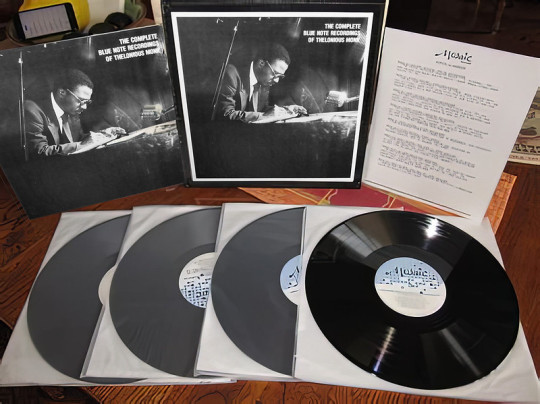
The first Mosaic Record box set 1983
There aren’t many people in the world like Michael Cuscuna. The world’s culture will miss him. I will miss him. Most of all, of course, his wife and children will miss him.
youtube
0 notes
Text
Joan Jett & The Blackhearts - I Hate Myself For Loving You
#Joan Jett & The Blackhearts#Greatest Hits#I Hate Myself For Loving You#Format:#CD#Compilation#Reissue#Country:#Europe#Released:#May 10#2019#Genre:#Rock#Style:#Punk#Pop Punk#Pop Rock#USA
35 notes
·
View notes
Text
Talking with Jeff Gomez
This month marks the 30th anniversary of the No Alternative compilation album. 1993 was a year of several landmark alt-rock albums including Radiohead's debut Pablo Honey, Liz Phair's Exile in Guyville, U2's Zooropa, The Breeders' The Last Splash (read my review of the recent reissue), Pearl Jam's Vs. and of course Nirvana's In Utero, but this compilation album of alt-rock artists encapsulated so much of what was happening in the Alternative Nation in 1993. It was a benefit for the AIDS charity Red Hot Organization and it featured some of the biggest names at the time as well as rising stars and veterans, i.e. Matthew Sweet, Buffalo Tom, Soul Asylum, Urge Overkill, Goo Goo Dolls, Pavement, Smashing Pumpkins, Soundgarden, Sarah McLachlan, Bob Mould, Uncle Tupelo, Beastie Boys, and the aforementioned Breeders and Nirvana. Writer Jeff Gomez, who has written several books about Gen X and alt-rock, has written an entire book about this buried treasure of an album to commemorate the 30th anniversary with There Was No Alternative, released earlier this year from McFarland publishing. I recently caught up with Mr. Gomez via zoom to discuss this book.

author Jeff Gomez
Me: How did this book come about in terms of telling the story of this album in book format (as opposed to podcast, etc)?
JG: It's interesting, the book I wrote was not the book I envisioned, I think what I envisioned was going to be much more like a Chuck Klosterman book, where it was very much looking at the 90s and Generation X. Then when I began to talk to the actual producers of the record, the story I discovered was a story of friendship. I had no idea going in. I knew it was a Red Hot record. I naively thought it was Red Hot's idea to do a grunge or alternative record. As I talked to the folks involved, I discovered it was this guy Paul Heck, whose idea it was to do the record along with his two friends from college. As I talked to Chris Mundy, Jessica Kowal and Paul Heck - again it was a story of friendship and activism in the early 90s. So it shifted from being a cultural thinkpiece like Rob Sheffield / Chuck Klosterman - into a story of friendship and what the 90s meant to people and how they tried to make a difference. In terms of politics, I needed to dive back into that election and remember figures like Paul Tsongas and Mike Dukakis. People I had not thought of in decades.

the No Alternative album cover
Me: For me, I was a junior in high school in the Fall of 1993. I was a huge fan of several artists on the No Alternative album, including Nirvana, Matthew Sweet, Smashing Pumpkins, Soundgarden, but then there were several artists where I knew a song and then this compilation was the gateway to learning more about them. Were you, yourself, a fan of these bands at that time?
JG: I was a little older than you, I was 23 when it came out. I was much more on the indie rock side. The only group I was really into at the time I got it was Pavement. So I was much more into Pavement, Sebadoh, Guided By Voices. I might've bought it for Pavement, but I thought I was a little too old for the grunge scene, but I was a big fan of Nirvana's song that was on here ["Verse Chorus Verse"]. So it was a little bit of an intro for me to some bands. Beastie Boys I really liked, Breeders I really liked. [Jeff holds up his CD of the album and I laugh because I hold up mine as well]. It's funny on social media when I announced this book, a lot of people said "I still have the album", "I'm going to go to the garage and dig it out" and the reports that came back were that it still holds up today!
Me: You, yourself, write a great deal about Generation X, which I am a proud member of. There seems to be some debate about the exact ages of Gen X. For some it's the 13th Generation, which is anyone born between 1961 and 1981. Others consider it anyone who was born in the 70s. But the most common definition is anyone born between 1964 and 1980. But whatever your definition is, if you were in your teens or twenties in 1993 this album spoke to you! Based on the featured musicians, the benefit for AIDS and the approach to the benefit album. Did this release at that time, speak to you specifically?
JG: It did, but one of the things I investigated looking back is that I was not a political person and I was not into the activism side of things. I was 23 and I was very much wrapped up in my own thing: trying to get a writing career off the ground, dating and in a band. I was a little bit of the Gen X stereotype of someone that was not thinking much beyond myself or my own circle, and what impressed me as I delved into the story of those who made this record is that they were not like that. Paul Heck, the man who really produced this record wanted to do something in music, but was seeing people sick on the streets of New York. As a straight man he was not directly effected by the AIDS crisis, although certainly heterosexuals did have to worry about having it. But he just knew that something was wrong in the country and in the government that these people were sick and he wanted to do something about it. So he decided that this charity album would be a way to raise awareness and money for the cause. Whereas I had my little apartment, my Fender Mustang, was in my cheesy indie rock band and was very much in my own world. I was one of those people who was in it for the music and was not thinking much larger than that.
Me: With this book you did a deep dive, looking at all different angles: the producers who were putting it together, the Red Hot Organization, each of the artists, the issues that Gen X was facing at that time. What was the biggest thing that you learned when you were writing this book?
JG: I think it was really about the AIDS crisis and what the Gay community did in terms of activism with Act Up and how effective they were. Again, I was very much in my own little world at the time. It also might be a case in the last 30 years, the biggest development is the internet. If it wasn't in Alternative Press magazine at the time, I probably didn't know much about it. I wasn't really reading the L.A. Times, was watching a little bit of TV but didn't even have cable at the time. So some of these really big issues were not really on my radar at the time, other than knowing I had to be safe for my own personal safety. So really it was how big the activism was with Act Up, how much they achieved in a short time and getting lower prices for AIDS drugs. And it was really interesting in seeing the parallels between COVID and AIDS.
AIDS was a global pandemic that was almost immediately politicized. Bringing up condoms was looked at as a political thing rather than a personal safety thing. Thirty years later, it was masks. It was really disheartening to see how far we haven't come. A larger pandemic with COVID in that it was inescapable to every person on the planet. So seeing those parallels was really interesting to me and wanting to dive into that.

book cover
Me: Was there anyone you wanted to interview for this book and for one reason or another you weren't able to get them?
JG: Oh yeah, if you look at the track listing, I went after everybody. I would've loved loved loved to talk to some of The Beastie Boys and Sonic Youth. The manager of The Beastie Boys literally laughed at me on the phone. And Nirvana. The same management company represents Beastie Boys, Sonic Youth, The Breeders and Nirvana - it's John Silva Management and he's been managing them for 30-40 years. He [John Silva] laughed and said 'they're not going to talk to you'. Also - Michael Stipe did a short film for the VHS and MTV special, so I reached out and his rep was very polite and said that he was unavailable. But I'm a big Patti Smith fan and certainly would've loved to have heard from her thoughts on Robert Mapplethorpe at that time. But the people I did reach were great and gave me the time. One of the things that was great was some of the bands that were not on my radar at the time and were great like the Goo Goo Dolls. Those guys couldn't have been nicer. The guys in Urge Overkill couldn't have been nicer. So thirty years on knowing who they are now and talking to them and they couldn't have been nicer was satisfying.
Me: Looking at the album and reading the book, it's actually kind of sad and bittersweet that so many of the artists are no longer here, including Kurt Cobain of Nirvana, Chris Cornell of Soundgarden, Adam Yauch of The Beastie Boys, Karl Mueller of Soul Asylum, Blackie Onassis of Urge Overkill, Gary Young of Pavement and Lance Diamond. So this album is really a document of a moment in time of so many of the artists we've lost since then.
JG: Yeah, I guess that's where the number 30 comes in. 30 years on some of the people who were in our world are now passing away, some from natural causes. And Yauch was just about my age and he succumbed to cancer and it's a scary thing putting myself in that head space of when this album came out, my biggest concern was "do I have enough money for Domino's Pizza or go out on a date on a Saturday night?" Now here we are middle-aged and having to deal with some pretty big issues and what's that like?
Me: There were a ton of benefit concerts and albums in the 90s, notably the Freddie Mercury Tribute concert for AIDS and the Tibetan Freedom Concert. Why do you think it is that the No Alternative album has had such an impact and is still remembered so fondly today?
JG: I think it was such a great microcosm of the moment. I also think it was a little bit more sly and subversive than some of those other things, because - and this really speaks to John Carlin and the Red Hot Organization's approach - he had this idea of being a trojan horse. Where they produce this really spectacular artifact, that you bought because just like me I bought it for the Nirvana track and the Pavement track, and then you begin to read the liner notes and it's not such a heavy handed delivery, it's very subversive, it gets by on osmosis. That helped it last over time. Also, how classic it is. As you say, there were other alternative compilations at that time, and what's so classic about this is that the design doesn't really seem dated in that 90s way, whereas if you look at some of the other stuff that looked like it had that Raygun Magazine, with that crazy font and the lettering, or early photoshop, what it really just screams "This is 1993" in a way, whereas this feels more classic.
For info on There Was No Alternative book
#interview#jeff gomez#there was no alternative#no alternative#nirvana#soundgarden#smashing pumpkins#the breeders#the beastie boys#patti smith#music nerd#books
0 notes
Text

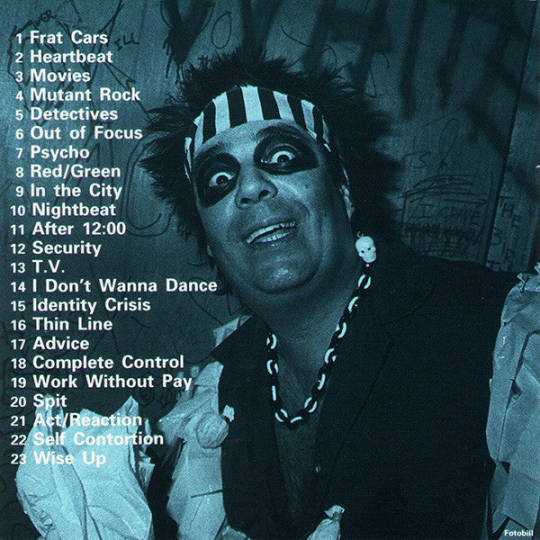

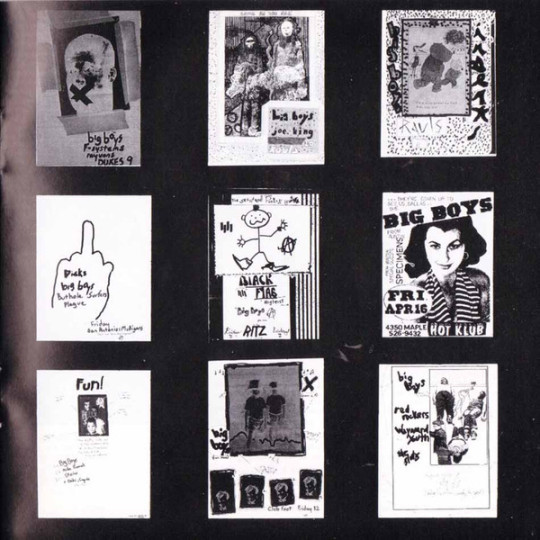




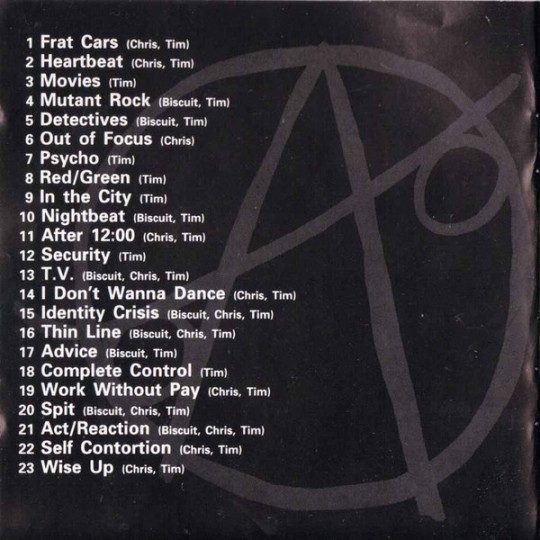

ALL THE MUTANT ROCK YOU CAN HANDLE ON ONE CD -- 23 ROCKIN', STOMPIN' CLASSIC CUTS IN ALL.
PIC(S) INFO: Spotlight on the "Skinny Elvis" CD compilation by Austin, Texas punk rock/art punk/hardcore/punk funk band, the BIG BOYS, collecting all of their 1980-'81 recorded output, and released for the first time ever on the CD media format by the Touch and Go label in 1993.
"In 1992, with the remastering and assembling help of Tim Kerr and longtime producer Spot, Touch and Go thankfully reissued the entire Big Boys oeuvre on two discs, preserving what by then had become a terribly out-of-print or hard-to-find back catalog scattered across several labels.
As the title implies -- also making a joke on the then current decision between a slender or portly Presley for a stamp -- "Skinny Elvis" collects the releases from the first part of the Boys' life in 1980 and 1981. Including the hyper-rare debut single "Frat Cars" was a good move to start with, while adding the Boys' half of the "Recorded Live at Raul's Club" split album and "Where's My Towel" resulted in a killer hour of BIG BOYS brilliance.
The sound is faultless, letting the Boys jump out of the speakers like never before. Complete release notes are a bonus, as are reproductions of the original sleeves. The real fun in the packaging, however, comes from the tons of archival photos and testimonials from other musicians: Henry Rollins, Thurston Moore, Ian Mackaye, and Gary Floyd, among others, offer up some amazing stories -- the recollections of the live shows make even the outrageous concert snapshots look tame -- and Byron Coley gives a nice precis of the band's history.
The funniest bit has to be the rejection note from Columbia Records in 1980, wherein a perhaps well-meaning but still clueless executive tries to give "honest advice," only to inadvertently expose himself as an out-of-touch old fart. As for those photos, seeing Turner in a wig, makeup, and some sort of sequined or lame top with a baby-doll leopard-skin semi-mermaid duct-taped to his wrist is just one highlight of many."
-- ALLMUSIC, BIG BOYS "The Skinny Elvis" CD compilation review by Ned Raggett
Rock in Peace, Randy "Biscuit" Turner (1949-2005) and Glenn "SPOT" Lockett (1951-2023), more legends lost.
Source: https://timebomb.co.jp/en/products/big-boys-%E3%83%93%E3%83%83%E3%82%B0-%E3%83%9C%E3%83%BC%E3%82%A4%E3%82%BA-the-skinny-elvis-us-limited-cd-new.
#BIG BOYS#BIG BOYS band#Texas punk#Art punk#Hardcore punk#80s hardcore#Punk funk#Skate punk#American Style#Touch and Go Records#Randy Biscuit Turner#Collage Art#Punk Art#Punk rock#80s punk#American hardcore punk#The Skinny Elvis#Skinny Elvis#Skate rock#American hardcore#Austin punk#CD Compilations#Sleeve Art#Compact Disc#Graphic Art#Graphic Design#Mutant rock#Touch and Go#CD#80s
0 notes
Photo


Clown Prince of The Menthol Trailer Guided By Voices (Domino) (released in 1994)
(This is the fourth of four entries concerning the seven inch EPs which comprise the recent Guided By Voices compilation Scalping The Guru which I discussed first on 30 October and then again 19 November.)
This EP came out on Domino which is in the UK. My brother found it mid-week at Record Swap (I did work for a living in Decatur, so I couldn’t always make my way to Champaign until Saturdays, although that would change in time when I would zoom to Record Swap on my lunch hour). But he found it underneath the 45 table. Rooting around to see what was hidden away he discovered this EP and called me to tell me (or perhaps sent me an email telling me of his find). He did indicate there was more than one copy under that 45 table, so I made my way there that following Saturday and landed my own copy. This felt like a huge find at the time! Domino also released this on CD in 1994 in a digipak. At the time, GbV was always bought on vinyl as it just seemed more suitable. Like most everything, that changed in time and for a long time I ended up buying them on both formats, depending whether or not they made a CD of whatever was being released at the time. Recordhead Records also reissued this on seven inch vinyl in 1998.
Above are the front and back of the picture sleeve. Below are the labels from both Side 1 and Side 2.


0 notes
Text
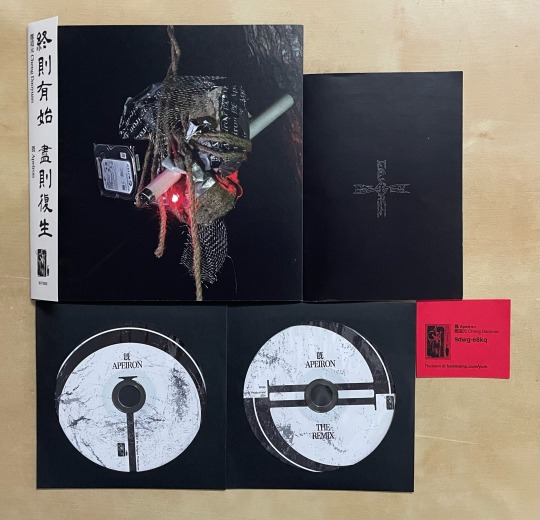
appearance on 鄭道元 Cheng Daoyuan - 旣 Apeiron(wv sorcerer productions/france 2*cd 2024)
▼WV092: 鄭道元 Cheng Daoyuan - 旣 Apeiron
終則有始,盡則復生
Everything is nothing, and the ending is the beginning.
Fragments are embedded in contemporary life, from which we can not escape. The music of Taipei-based dark experimental sound activist Cheng Daoyuan is just such a journey through endless fragments, layers of sound textures and samples, building his own unique artistic vision between old-school post-industrial music and contemporary soundscapes. Dark ambient, harsh noise, glitch, gabber techno, digital distortion, ghostly vocals, pale but full of tension, "旣 Apeiron" comes from the abyss and goes into the future, reborn from the ashes, where the end is the beginning, invisible and without boundaries.
Previously released on cassette tape by Future Proof : 面向異日 in 2019, and now reissued by WV Sorcerer Productions as a double CD, 7" format trifold cover with obi, and a 24-page booklet of the artist's visual work. Including a feature appearance of Mong Tong on “幽示 Divulging” and 7 remixes from: Yearning Kru, YunHao, Wa?ste, A.P.R.A (破地獄 Scattered Purgatory), Nerve, Coalminer, and Torturing Nurse.
碎片,嵌入在當下生活之中,你我都無法逃脫。來自台北的黑暗實驗聲響活躍分子鄭道元的音樂,便是在無窮盡的碎片裡穿行,由無數聲音材質和採樣堆積起的聲音片層,在傳統後工業音樂和當代音景之間構築起屬於他自己的獨特風格。黑氛圍、粗噪音、錯音、硬蕊電子、數位扭曲音牆、幽靈般的人聲,蒼白卻又高壓,《旣 Apeiron》來自深淵,走入未來,從灰燼中不斷重生,終點即是起點,無形無界。
▼
"Waves of distortion crash into, and over one another; buried tones are barely visible in a dark sea of fuzz and decay, occasionally drifting towards the surface to groan...
...combining the paranoid digital tones with false reassurances of open spaces and natural tones. Haunted voices, cryptic announcements from tannoys and even bird sounds appear."
- Future Proof : 面向異日
▼
Cheng Daoyuan is a multidisciplinary artist from Taiwan, engaging in various forms of creation including experimental sounds, visuals, and installations. His sonic expressions are based in dense, murky post-industrial textures, melding with diverse elements to sculpt a unique apocalyptic style, aiming to present the philosophical imagery of coexisting opposites, with the concept of the convergence of two distinct planes into a coherent form threading through his works.
In addition to being actively involved in the sound scene in Taiwan for many years, his sounds have been released internationally through albums, compilations, and remixes on multiple labels and platforms. In recent years, he has expanded his sonic aesthetics into the fields of multichannel audio, mixed media, and physical theater, presenting in venues such as art galleries, museums, and experimental spaces.
鄭道元是來自臺灣的多領域藝術家,創作涵括實驗聲響、影像與裝置等形式。他的聲音以混濁厚重的後工業質地為基底,並與各種不同元素揉合後形塑獨特的末日風格,試圖呈現對立共存的哲學意象,將一體兩面作為核心概念貫穿於作品。
除長年活躍於臺灣聲響場景外,他的聲音也以專輯、合輯及混音等形式發表於多國廠牌及平台,近年更將聲音美學拓展至多聲道、複合媒材及肢體劇場等領域,並於美術館、藝廊與實驗空間等場域呈現。
www.chengdaoyuan.com
credits
releases April 5, 2024
Disc01
All tracks by Cheng Daoyuan 鄭道元
Track 8 with Mong Tong
Mixed & mastered by Hom Yu 洪御
Disc02
Tracks by remixers
Mastered by Thomas Stadnicki
Installation, artwork, design, and layout by Cheng Daoyuan 鄭道元
Cover photo taken by Danist Wen 曾文廷
Artist portrait by Wu Wenyi 吳汶憶
© & ℗ WV Sorcerer Productions 2024
www.facebook.com/wvsorcerer
www.youtube.com/c/wvsorcerer
Instagram: @wv_sorcerer_productions
巫唱片
chengdaoyuan.bandcamp.com
www.facebook.com/chengdaoyuan
Instagram: @clansiechengdaoyuan
www.chengdaoyuan.com
order:https://wvsorcerer.bandcamp.com/album/apeiron
1 note
·
View note
Text



13 January 2024: VU, The Velvet Underground. (2000 Japan Verve reissue of 1985 Verve release)
There's a bit of a Japanese mini LP resurgence happening in my household, and you can tell from my 2024 posts so far that there's an ongoing glut of Velvet Underground purchases, too.
In 1985 this outtakes and oddities compilation of previously unreleased material surfaced; this was the first appearance of "new" Velvet Underground music since the 1974 issue of 1969 Velvet Underground Live with Lou Reed, and fans went bananas for it. Even today this comp (and its 1986 follow-up Another View) gets hailed as essential. Much of the music on these mid-'80s comps are now available as part of comprehensive box sets, but taken on their own they make for good, album-length listening.
A college girlfriend had this and I found it even more baffling than I did her copy of 1969 Live. I barely had a working knowledge of the band's studio output at the time, let alone understand how their outtakes fit into the picture. I recall her talking endlessly about the VU track "Andy's Chest," which Reed later recorded for his 1972 solo album Transformer; the VU version here is from 1969. (It went on to become one of my least favorite tunes in the entire VU universe.)
Later this year as part of my three-year VU catalog study, I'll come to the point in the natural Velvet Underground chronology and I plan to spend a month each with VU and Another View. While perusing the online inventory of local chain Reckless Records, I happened to see they had a used copy of a Japanese mini LP edition of Another View, which I didn't own in any format; I called and asked them to hold it for me. A few minutes later I saw they also had one of VU, which you see here. Rather than call them back I just crossed my fingers and hoped it was still on the shelf when I would visit the next day. It was, and that's what you see here. I already had a standard jewel-case edition of VU, but when both comps are available to me on mini LP you can bet I'm buying them both.
Above we see the front cover, first with obi and then without, followed by the back cover sans obi. I forgot to photograph the back cover with it.
Next up is the front of the booklet; it's just a purely black-and-white version of the front cover art.

Next we have both sides of the insert.


Last, here is the CD itself.

0 notes